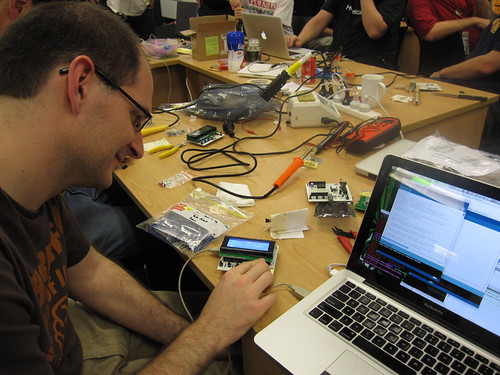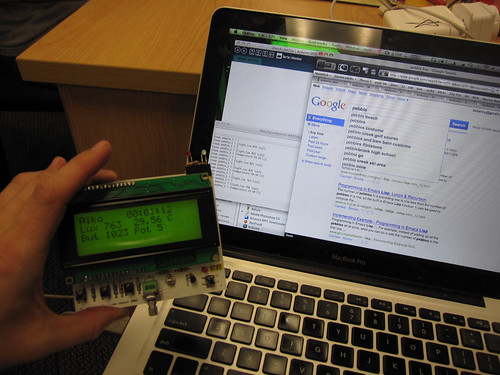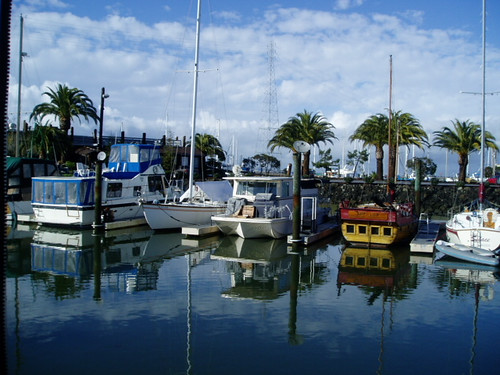I came into this room with a jillion people soldering and just finishing their Arduino pebble thingies and some madman crouched by my wheelchair to explain how to mindmeld with it. After a bunch of fiddling and more kibbitzing by a guy named Garth we got this other one working. I am incoherent! Because jetlag, and I'm in New Zealand at day something of linux.conf.au.
Here's how to do it! On a mac! Incoherently! And not quite like this, which is full of lies.
download arduino software
download drivers
You will have to restart your Mac.
download source of Aiko from github. (You do not need to go figure out github right now, just click on "download source")
move that into ~/Documents/Arduino and unzip it.
It needs to be like this:
docs/ nursery/
aiko_gateway/ examples/ pebble/
aiko_node/ libraries/ tests/
And in:
~/Documents/Arduino/libraries:
Aiko/ PString/ pebble_relays/
NewSoftSerial/ PString2.zip pebble_relays_aiko/
NewSoftSerial10c.zip pebble/ pebble_temperature/
OneWire/ pebble_display/
OneWire.zip pebble_ldr/
And thusly:
~/Documents/Arduino/libraries/Aiko:
AikoCallback.h* AikoDeviceSPIBus.h* AikoSExpression.h*
AikoDeviceMCP320x.cpp* AikoEvents.cpp* AikoTiming.cpp*
AikoDeviceMCP320x.h* AikoEvents.h* AikoTiming.h*
AikoDeviceSPIBus.cpp* AikoSExpression.cpp* Makefile*
You will be missing a bunch those files and the might not be in the right place. So move them around!
Download and unzip into ~Documents/Arduino/libraries:
http://www.pjrc.com/teensy/arduino_libraries/OneWire.zip
http://arduiniana.org/NewSoftSerial/NewSoftSerial10c.zip
http://arduiniana.org/PString/PString2.zip
Then plug in your Pebble! Yay!
Open Arduino application which you downloaaded earlier.
Select the Serial Port from the Tools menu.
Go to File--- Sketchbook -- aiko_node
Click Verify in the button toolbar
It should compile
Click the upload button in the toolbar
It turns on! yay!
Make sure to select the serial port in "Tools".
Click the Serial monitor button in the toolbar. It pops up another window.
select 38400 baud in the dropdown menu
Your Pebble should talk to you now!
thusly:
(node pebble_1 ? (temperature 27.87 C))
(node pebble_1 ? )
(node pebble_1 ? (light_lux 854 lux))
(node pebble_1 ? )
(node pebble_1 ? (light_lux 854 lux))
(node pebble_1 ? (temperature 27.87 C))
(node pebble_1 ? )
(node pebble_1 ? (light_lux 855 lux))
(node pebble_1 ? )
Tell it this:
(relay on);
(relay off);
(relay2 on);
(reset_clock);
You have now Impressed the Pebble. Name it something like R'duinoth. Huzzah!
Wednesday, January 20, 2010
Connecting to a Pebble
Posted by
Liz
at
1:29 AM
2
comments
![]()
![]()
Labels: electronics, fun, hardware
Friday, January 15, 2010
Beyond underwear: Useful things for crisis situations
A friend just asked me what would be useful to send to Haiti or to any evacuee camp, refugee camp, or disaster situation besides food, water, and medical supplies. She had the opportunity to send a box immediately by small aircraft and had to send things that were in her house already. So, here's my question for you. Other than food, water, and medical supplies, what would you list as non-obvious and useful in a disaster?
Here is my list.
Backpacks - things to hold other things
Tape - all kinds but mainly duct tape, electrical tape, and masking tape
Scissors
Pocketknife
Notebook
Sharpie markers
String or strong cord
Safety pins, binder clips, rubber bands
Ziplock and other plastic bags, all sizes
Handkerchiefs or bandanas
What would you add to that list?
My list is heavy on the office supplies but that's because I believe that information is power. With paper, a Sharpie, and some good tape, you become an instantly powerful distributor of information, because you can create useful signs that spread information efficiently. The list is strangely similar to what I'd recommend you need to organize an impromptu conference.
I still believe that along with food, water, shelter, and medical care, information is a primary need.
Given a point of internet access, priority should be on peoplefinding and information booth services. For peoplefinding, register people for email if they don't have it - Gmail is excellent- and on some existing popular social software. I think Facebook is ideal as they have okay privacy controls, useful for limiting volatile family details. Their neighborhood and group features are useful for finding, say, everyone you can think of who you work with or who lives on your block. Full names (which is what official databases go by) aren't useful when you're trying to make sure that lady who works on your shift or your neighbor "Bud" are okay because you heard that their sister's looking for them. Sign people up for email and make sure they understand how to get back into it. Sign them up on some social software, and friend them and get them to friend you back. You are now a point of contact for anyone who knows them. Do this with everyone you speak with, and you'll be doing something very useful!
In Katrina relief efforts I found that evacuees needed backpacks and tools to carry information -- notebook and pen, or a small folder or even a manila envelope, were crucial as they started to get paperwork, ID, and have to take notes on where to go for what resources, who they've seen, talked to, lists of people they're trying to find, and so on. Since officials, army and police would often just move cots and trash bags full of people's rescued (or newly received) belongings, a backpack is much better so people can carry essentials around.
Posted by
Liz
at
12:04 PM
6
comments
![]()
![]()
Labels: disaster relief
Saturday, January 02, 2010
Living in a boat
A month ago I moved onto a boat, a 37 foot Chris Craft Catalina built in 1987. The engine is in scattered rusted pieces. There's a faint bilgey, seaweedy smell and a gentle rocking motion. Pelicans, grebes, coots, ducks, geese, scaups, cormorants, and night herons hang around the harbor outside my window.
Last night for the first time, during a minus tide (a perigean spring tide) the boat grounded on the muddy bottom. Then there was a moment where the boat began to sway again - it had lifted off and we were floating. I looked out at the christmas lights in the rigging next door and realized we were at our usual height relationship again, with a view of the canvas roof over their cockpit. While we were both grounded, their deeper keel hit bottom first, and their boat towered over us so that I was looking into their lower portholes from my cabin window.
It's all a bit like a trailer park in a very wet parking lot. Some people's boats sail out into the bay or to far destinations. Others, like mine, stay put except for the promise and motion of the tide. People who have boats, and who live aboard their boats, seem to share a particular romanticism, dreaminess and the attachment of meaning to possibilities of a nomadic life, or a sense of needed refuge, shown in lists of the most popular boat names over the years.
Tides are complicated. On this part of the coast we get mixed tides -- with high water and low water twice a day, and one set of high and low points higher than the other. The tide moves north along the U.S. west coast because of the Coriolis effect. Here in the bay, down a marshy creek channel and in the middle of a slough, the tidal range is still over 8 feet. Floating docks and finger docks are loosely connected to piers by huge metal rings. Sometimes we on the boats, and the docks that bridge the water, are up at the level of the parking lot. At low tide, the ramp from the parking lot to the docks is quite steep.
Dock steps with a handrail lead up to my boat. Between the main cabin and the other rooms, there are a few more steps. These are still hard for me to negotiate, especially stepping down. But through the stress of moving I've held up very well. Now that I'm settled in, the constant small variations of the steps between rooms, with resting possible in bed or in the living room and kitchen, are making my knees stronger.
The head in the aft (captain's) cabin works well. The forward head has been in pieces for over a week, waiting for an out of stock valve to be shipped to one of a small group of my neighbors who have been in and out of the boat to study the valves and hoses below deck and the disassembled hoses attached to the toilet itself. I've learned a little bit about marine heads in the meantime. Everyone here gets to know the marine shop and the RV supply places, and, I think, the workings of each other's boats.
The boat had two circuits of 30 amps each. Space heaters, the microwave, and the toaster oven use the most amps and can potentially flip some circuit breakers. There's a 12 volt circuit too for the boat's batteries, and the bilge pump runs on that. Though the water and electricity are hooked up to the city services, I'm suddenly more aware of them as finite resources, and am now much more moderate in my use of both. My neighbors can see the water I use to wash dishes, as it's pumped out over the side. The toilets' holding tank is pumped out twice a month into a boat with a giant holding tank, with all our sewage sloshing around visibly inside.
A small subset of my books fills three half-size bookshelves. I brought a lot of books about exploration and the sea, fiction and non-fiction. So far the best one has been The Loss of the Ship Essex, Sunk By a Whale. Three survivors from the 1820 wreck of a whaling ship tell the story of the whale's attack, a long journey in three open boats, starvation, thirst, fear, and cannibalism. My other favorite book just now, a present from Oblomovka, is The Queen of Whale Cay, about a woman named Joe Carstairs who drove ambulances in WWI, raced motorboats, had about a zillion lovers including Marlene Dietrich, and bought her own island in the Bahamas which she ruled feudal or colonial style until the 1960s. Every paragraph of the book was full of new outrageousness. I also brought some books of poems to translate, and some of my favorite poets like Ginsberg and Alta.
By comparison to many other towns on the Peninsula, Redwood City has kept a little bit of its working class industry and feel, in part because it's a working deep water port. Ships from China and South Korea bring construction materials, like gypsum and rock for cement. They leave filled with scrap metal. On one side, a complex of tall buildings is built around a rocky artificial stream, then some salt ponds shade towards more slough and a landfill to the south. On the north side of the port, there's a yacht harbor surrounded by tech and genetics companies in a chain of long low buildings and their oceanic parking lots. Then, bits of slough and winding creek channels. At the point where Redwood Creek crosses 101, there's a marina called Docktown, with some enormous "floating homes" built on pontoons, and boats ranging down to the "barely floating" category. There are lots of flowerpots and dogs and amazing, attractive clutter, and a completely non-snooty yacht club. I like it there. My boat is in Pete's Harbor, a quiet marina just across the creek and around a point, facing Bair Island and Smith Slough. The liveaboards here all seem to know each other and it's a good community. Two newer marinas in town, West Point and Bair Island, are stricter in their rules and are out to attract a richer set of residents. But my impression of Docktown and Pete's Harbor is that people here are just regular -- not wealthy yacht owners -- and in fact it's very affordable to live on the water here once you have the boat and a slip to rent. The politics of the existence of marinas seems as complicated as tides and less predictable. Here is an area in flux, whose ownership is a bit unclear or is municipally owned. Would it even be possible to own a tiny bit of the coastline in the bay, here? Could it be possible for a consortium or co-operative to buy up some land and own their own personal boat slips, rather than renting the slips? I wonder, too, if that would inevitably lead to people filling in the spaces between docks and new land pushing outward into the Bay, as much of San Francisco was built on docks and filled in to become land, owned and controlled rather than the liminal space that coastlines seem to be.
As I read about the complexities of tides I learned about amphidromic points, places in the ocean where because of the Coriolis effect, the topography of the sea floor or the nearby landmasses, the tidal range is zero. The tides here keep me noticing things and alert to this small bit of the world. I'm paying attention to weather and watching the marine buoys nearest to the harbor.
Anyway, the changes in my life have been overwhelming and absorbing, so much that I haven't been blogging much or spending time online, other than for work. I need to jump back in, though, and in a couple of weeks am leaving for New Zealand for linux.conf.au and DrupalSouth. Wellington is on Cook Strait, between the North and South Islands of New Zealand. On the east coast, high tide comes at the same time as low tide on the west coast. So the current through the channel is fierce and for various reasons, nearly unpredictable. A bit like my interest in geology and gardening and compost made me notice dirt and rocks and want to learn about the geological history of every place I go --- seeing a landscape as a potential narrative over the scale of geologic time and simultaneously from the point of view of a gardener --- living aboard a boat (which happened somewhat by chance as I looked for a cheap place to live in my town on Craigslist) has given me a new overlay or template or lens to view the rest of the world. So there's a new set of things to learn and notice, everywhere I go, which makes me feel incredibly lucky and happy. The rock and soil based lens of my view is about deep history and rootedness, and how to settle and blend into that landscape, making a sort of habitat or ecosystem where I make a home for birds and bugs, getting back some tomatoes and oregano and flowers. Here on the water in my glorified floating trailer, I find I've made the same sort of cozy domesticity inside the house, but outside, there's no feeling of rootedness or connection. I'm detatched, ephemeral, temporarily in residence, trying not to make an impact with my biodegradable soap, an observer and traveller. What would it be like, living in a spaceship? It's like what that anthropologist whose name I can't recall wrote about the attractions of waiting rooms and hotel lobbies. But rather than waiting in an impersonal static lobby for a particular event, I'm a temporary resident along with the ducks and herons as enormous forces keep our world in flux.
Posted by
Liz
at
8:19 AM
4
comments
![]()
![]()






